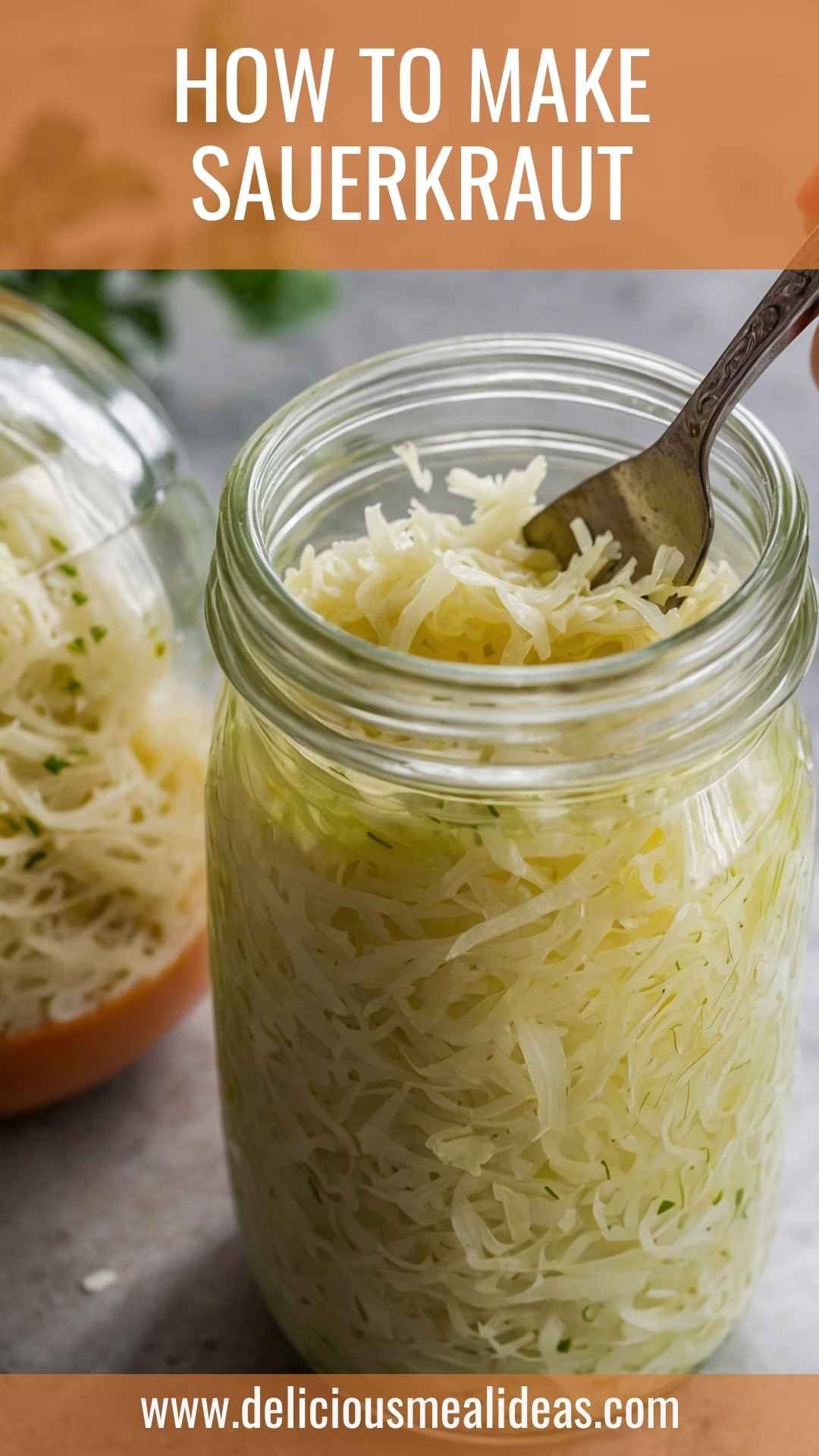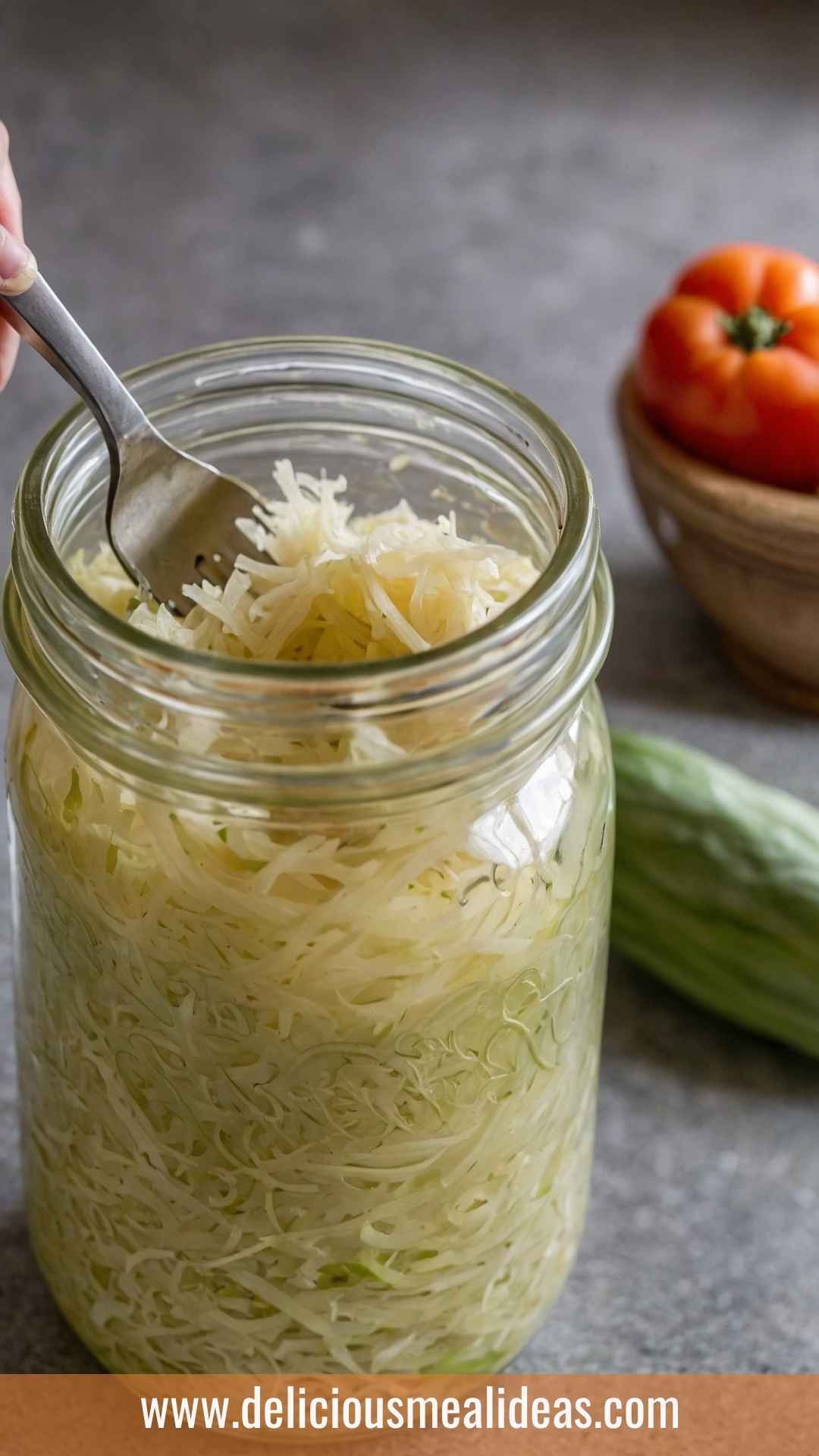If you’ve ever skipped over the humble sauerkraut in the deli, it’s time to reconsider. This tangy, fermented cabbage isn’t just a sidekick; it’s a power player in the culinary game. Think of it as a superstar topping for your favorite bratwurst, or as an unexpected twist in a savory salad.
A hot dog dressed in a cascade of zesty sauerkraut or a Reuben sandwich, layered thick with this crunchy concoction. You can also enhance a cheese platter with a scoop of this fermented delight, creating a fantastic contrast of flavors.
Believe me, it pairs brilliantly with roasted meats, elevating their flavor profile to new heights.
Ready to dive into this delightful cooking journey? Let’s get started!

What is Sauerkraut?
Sauerkraut is fermented cabbage, celebrated for its distinctive flavor and health benefits. It has roots in Germany, where it’s been enjoyed for centuries.
The fermentation process not only preserves the cabbage but also enriches it with beneficial probiotics. This tangy delicacy enhances various dishes and stands out on its own.
Why This Recipe Works
1. Simplicity: Making sauerkraut requires just a few ingredients: cabbage, salt, and optional spices for flair. This straightforward approach ensures anyone can try their hand at it, regardless of experience.
2. Health Benefits: Fermented foods like sauerkraut are rich in probiotics. These beneficial bacteria play a significant role in gut health, digestion, and even boosting your immune system. If you’re interested in gut health, sauerkraut is a delicious route to explore.
3. Customization: While the classic sauerkraut is fantastic, it can be tailored to fit your flavor preferences. Want a hint of spice? Go for caraway seeds! Prefer something a bit sweeter? A dash of grated ginger can work wonders. The options are limitless!
4. Cost-Effective: Cabbage is one of the most affordable vegetables. You can easily create a large batch at a low cost, making this a budget-friendly dish perfect for families or gatherings.
Ingredients You’ll Need To Make Sauerkraut
Gather your supplies; it’s time to get cooking! Here’s what you’ll need:
- 1 teaspoon of caraway seeds
- 2 1/2 pounds of cabbage head
- 1 tablespoon of freshly grated ginger
- 3 3/4 to 5 teaspoons of sea salt, approximately 1 1/2 to 2 teaspoons per pound of cabbage
When you have these ingredients in hand, you’re well on your way to crafting your very own sauerkraut!

How To Make Sauerkraut
Step 1: Prepare the Cabbage
Start with a fresh cabbage. Remove any outer leaves that may be wilted or damaged. Cut the cabbage into quarters, removing the core. Slice each quarter into thin strips. Aim for consistency; this helps with the fermentation process.
Step 2: Salt the Cabbage
In a large mixing bowl, combine the sliced cabbage with the salt. Now, this is where the magic begins.
Using your hands, massage the cabbage vigorously. You’ll notice the cabbage begins to release its natural juices. Continue this for about 5-10 minutes. It might feel a bit silly, but trust me, this step is crucial!
Step 3: Add Flavor (if desired)
If you’re using additives like caraway seeds or grated ginger, sprinkle them in now. Stir them into the salted cabbage. These additions will not only provide flavor but also make your sauerkraut unique.
Step 4: Pack into a Jar
Next, transfer the cabbage mixture into a clean fermentation jar or a large glass container. Press the cabbage down firmly as you layer it in.
You want to pack it tightly and ensure that the juices cover the cabbage completely. If you don’t see enough liquid, you can add a little extra saltwater (1 teaspoon of salt dissolved in 1 cup of water).
Step 5: Ferment!
Cover the jar loosely with a lid or a cloth secured with a rubber band. This allows gases to escape while keeping contaminants out.
Place the jar in a cool, dark area. Now comes the waiting game. Let it ferment for about 1 to 4 weeks, depending on your taste preference.
Step 6: Taste and Store
After a week, start tasting your sauerkraut. It should start to taste tangy and sour. When it reaches your desired flavor, transfer it to the fridge.
Doing so will slow down the fermentation process, and your sauerkraut can last for months in cold storage.
Tips & Tricks
- Use a Fermentation Weight: If you have one, a fermentation weight can help keep the cabbage submerged under the brine.
- Experiment: Don’t hesitate to try different spices like juniper berries or garlic for varied flavors.
- Check for Molds: It’s normal for some white scum to form, but if you see any black or fuzzy mold, discard the batch.
- Temperature Matters: Keep the cabbage in a cool area, ideally between 65-75°F. Too warm will speed up fermentation.
- Save Some Liquid: Keep a little of the brine for your next batch of sauerkraut as a starter culture.
How Do You Store The Leftovers?
Once you’ve opened your sauerkraut, store it in an airtight container in the fridge. It will maintain its flavor and crunch for several months. Just remember to keep it submerged in brine.
What Sides Would Complement Sauerkraut?
1. Bratwurst: Juicy and savory, bratwurst pairs beautifully with the tartness of sauerkraut. The rich flavors intertwine, creating a satisfying bite.
2. Mashed Potatoes: Creamy mashed potatoes balance the sharp acidity of sauerkraut. It’s a classic combo in many households.
3. Coleslaw: The crunch of coleslaw adds texture to meals with sauerkraut. Variations with apples or nuts bring a delightful twist.
What Alternatives Can You Use for the Ingredients?
- Cabbage: Try other cruciferous vegetables like kale or bok choy. They’ll provide similar results, with unique flavors.
- Sea Salt: Regular table salt can work, but avoid iodized salt as it can impact the fermentation.
- Caraway Seeds: Fennel seeds or dill can contribute a different, yet delicious flavor profile.
- Ginger: If you lack ginger, a pinch of cayenne or red pepper flakes can add a different kind of heat.

Conclusion
Making sauerkraut might seem trivial, but the flavor and health benefits it brings to the table are monumental. Diving into a project like this offers joy and satisfaction, giving your meals that sought-after zest without breaking the bank.
So whether you’re hosting a summer barbecue or simply spicing up a weeknight dinner, sauerkraut deserves a spot in your kitchen. Plus, customizing it gives you the freedom to create something truly aligned with your tastes.
So roll up your sleeves, grab your cabbage, and get started on this journey to making the best batch of sauerkraut you’ve ever tasted! Enjoy the achievement that comes with your own homemade goodness.
You’ll also like the following recipes!

How To Make Sauerkraut – Delicious Meal Ideas
Description
There's something about homemade sauerkraut that hits differently. It’s not just about the taste; it’s about the experience. I remember the first time I tried making it. The kitchen filled with an invigorating scent, and the anticipation of that crunch sparked joy.
Creating sauerkraut is one of those rare alchemies of simple ingredients transforming into something magical. The synergy of cabbage and salt results in a tangy delight that offers a kick to various dishes. Plus, it’s a fantastic way to introduce more probiotics into your diet.
In this article, I'll walk you through the process of making sauerkraut from scratch, sharing insights from my own experiences, and providing helpful tips to ensure your batch turns out perfectly every time.
Ingredients
Instructions
Step 1: Prepare the Cabbage
-
Start with a fresh cabbage. Remove any outer leaves that may be wilted or damaged. Cut the cabbage into quarters, removing the core. Slice each quarter into thin strips. Aim for consistency; this helps with the fermentation process.
Step 2: Salt the Cabbage
-
In a large mixing bowl, combine the sliced cabbage with the salt. Now, this is where the magic begins.
Using your hands, massage the cabbage vigorously. You'll notice the cabbage begins to release its natural juices. Continue this for about 5-10 minutes. It might feel a bit silly, but trust me, this step is crucial!
Step 3: Add Flavor (if desired)
-
If you're using additives like caraway seeds or grated ginger, sprinkle them in now. Stir them into the salted cabbage. These additions will not only provide flavor but also make your sauerkraut unique.
Step 4: Pack into a Jar
-
Next, transfer the cabbage mixture into a clean fermentation jar or a large glass container. Press the cabbage down firmly as you layer it in.
You want to pack it tightly and ensure that the juices cover the cabbage completely. If you don’t see enough liquid, you can add a little extra saltwater (1 teaspoon of salt dissolved in 1 cup of water).
Step 5: Ferment!
-
Cover the jar loosely with a lid or a cloth secured with a rubber band. This allows gases to escape while keeping contaminants out.
Place the jar in a cool, dark area. Now comes the waiting game. Let it ferment for about 1 to 4 weeks, depending on your taste preference.
Step 6: Taste and Store
-
After a week, start tasting your sauerkraut. It should start to taste tangy and sour. When it reaches your desired flavor, transfer it to the fridge.
Doing so will slow down the fermentation process, and your sauerkraut can last for months in cold storage.
Nutrition Facts
Servings 16
- Amount Per Serving
- Calories 184kcal
- % Daily Value *
- Total Fat 6.6g11%
- Saturated Fat 1.2g6%
- Cholesterol 5mg2%
- Sodium 441mg19%
- Total Carbohydrate 5g2%
- Dietary Fiber 2g8%
- Sugars 3g
- Protein 25g50%
* Percent Daily Values are based on a 2,000 calorie diet. Your daily value may be higher or lower depending on your calorie needs.
Note
- Use a Fermentation Weight: If you have one, a fermentation weight can help keep the cabbage submerged under the brine.
- Experiment: Don’t hesitate to try different spices like juniper berries or garlic for varied flavors.
- Check for Molds: It’s normal for some white scum to form, but if you see any black or fuzzy mold, discard the batch.
- Temperature Matters: Keep the cabbage in a cool area, ideally between 65-75°F. Too warm will speed up fermentation.
- Save Some Liquid: Keep a little of the brine for your next batch of sauerkraut as a starter culture.





